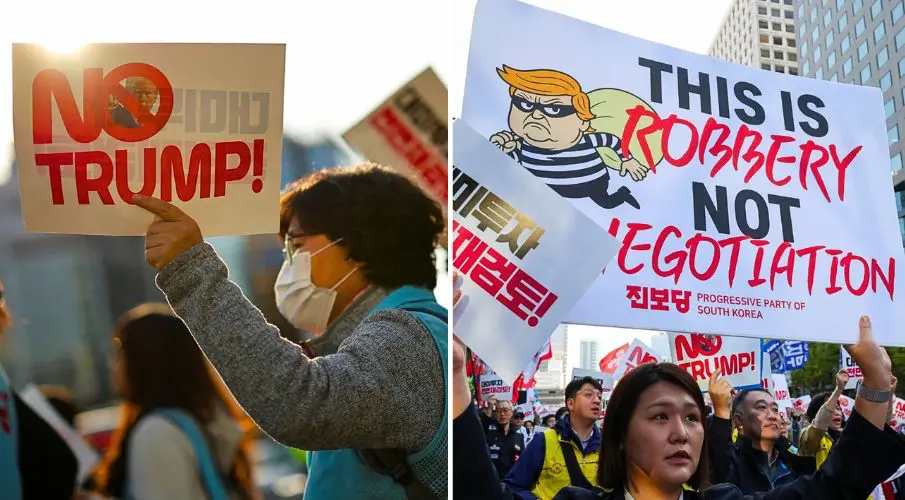In the narrow streets of Myeongdong, where tourists and street vendors compete for the same space, Lin Yung-pin leads a group from Taiwan through the maze of lights, scents, and voices. At his suggestion, some of his guests wear small signs on their backpacks - “We are from Taiwan.” Not out of vanity, but out of caution. Those who speak Chinese can become targets here. For weeks, South Korea has been experiencing a new wave of anti-Chinese protests. What began as demonstrations against relaxed visa rules for travel groups has turned into a broader upheaval, driven by far-right groups, nationalist bloggers, and former supporters of ousted President Yoon Suk-yeol. Their slogans read “Korea for Koreans” and “Stop the Chinese Boats.” Some openly chant racist insults.
For President Lee Jae-myung, it is a delicate situation. In a few days, he will host two state guests whose relationship could hardly be more complicated: Donald Trump and Xi Jinping. Both are arriving in Seoul for talks ahead of the APEC summit. And while South Korea tries to maintain diplomatic balance between Washington and Beijing, its own street protests threaten to steal the stage. Lee has sharply condemned the demonstrations as “self-destructive behavior that harms the national interest and the country's image.” His Democratic Party has introduced a bill in parliament to ban rallies that promote hatred or discrimination. But the conservative opposition calls it censorship and warns of an attack on freedom of expression. South Korea knows protest as part of its political DNA. “The country has one of the most vibrant protest cultures in the world,” says historian John Delury of the Asia Society in Seoul. “If the government cracks down too hard, it could mobilize more people - not out of hostility toward China, but out of solidarity with the right to protest.”

Anti-Chinese sentiment in South Korea has a history. After the deployment of a U.S. missile defense system in 2016, Beijing responded with economic sanctions and political pressure. Although relations later calmed, trust remained damaged - especially among the younger generation, who increasingly associate China with authoritarianism and interference. The current wave of protests has a different origin: demonstrations in support of former President Yoon Suk-yeol, who was removed from office in April after his short-lived declaration of martial law. His supporters - a loose alliance of right-wing activists and influencers - claimed that Beijing had manipulated South Korean elections. They adopted conspiracy narratives reminiscent of Trump’s “Stop the Steal” campaign and added their own twist: the fear of a “Chinese shadow state.”
Since Yoon’s ouster, the protests have taken on a life of their own. Alongside anti-Chinese slogans, demonstrators call for his reinstatement, attack President Lee, and loudly commemorate the murdered U.S. activist Charlie Kirk, Trump’s political ally, who was shot dead in Utah last month. Both governments - in Seoul and Beijing - are trying to portray the movement as a fringe phenomenon. The Chinese Embassy warned its citizens against traveling to South Korea, but also spoke of a “small group of far-right agitators” and emphasized that the majority of Koreans warmly welcome Chinese tourists. Yet the political risk remains. Every demonstration, every incident threatens to disrupt the fragile diplomatic choreography that Lee must maintain between Trump and Xi.

For tourists like Lin Yung-pin, the situation is mainly a logistical issue. He advises his groups not to speak Mandarin near protests and to avoid crowded areas. “If they are mistaken for Chinese, they just show their sign - then it’s fine,” he says with a practiced smile. Many visitors barely notice the tension. Brian Lu, 23, a livestreamer from China’s Guizhou province, traveled to Seoul after attending a concert in Incheon. “It’s nothing like what you read online,” he says. “People here are polite, they smile, they greet you - no one was unfriendly.” That is how South Korea presents itself these days: friendly, vulnerable, polarized. A country that has learned to endure protest.
Investigative journalism requires courage, conviction – and your support.
Please also strengthen our journalistic fight against right-wing populism and human rights violations. We do not want to finance ourselves through a paywall so that everyone can read our research – regardless of income or origin. Thank you very much!


Überall das Playbook der Hetzer.
Sicher ist China sehr übermächtig und Süd Korea ein kleines Land. Aber mit hervorragender Technologie.
Damit sind sie sicher für China interessant.
Aber erstmal liegt für China Taiwan im Fokus.
Da sie es ja Seiten vielen Jahren als abtrünnigen Teil Chinas, ohne Existenzrecht als eigenes Land betrachten.
Für Trump wird es wieder ein „Ich bin der größte Dealmaker“ Auftritt.
China ist diszipliniert, nie spontan und sicher nicht wirklich auf die USA angewiesen.
Welcher Deal auch immer kommt. China wird profitieren und Trump wird es als den ganz großen Deal präsentieren.
…ich bin gespannt wie das wird in südkorea, die stimmung ist aufgeheizt dort